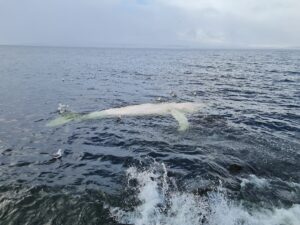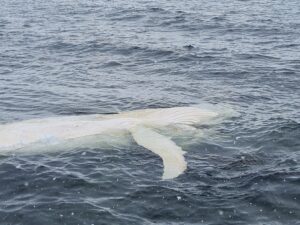A Whale Carcass in North Iceland
Last week staff from the Húsavík Whale Museum ventured to Eyjafjörður to take a closer look at a whale carcass on the beach below the farm Neðri-Dálksstaðir, as reported by mbl:
https://www.mbl.is/200milur/frettir/2024/03/26/hvalshrae_i_fjorunni_nordan_svalbardseyrar/.
After hiking down to the beach accompanied by some locals, the whale carcass was clearly visible, although the high-tide had submerged it.
The weather was cold and snowy, and a flock of northern fulmars could be seen sitting around it, occasionally pecking at the dead body.
The carcass was of a small humpback whale (Megaptera novaeangliae), discoloured from the decomposition.
It seems more than likely that the carcass is the same one spotted in Hrísey island last March, as reported by Vísir: https://www.visir.is/g/20242541562d/hrae-hnufu-baks-i-hris-ey-legid-lengi
The winds and currents seem to have brought it further into the fjord, and it could end up traveling more before breaking down completely. But only time will tell.
Exhibition update.
End of summer
Húsavík Whale Museum’s attendance numbers from June-August 2020 were 11.500. That’s roughly 1/3 of the visitor numbers during the summer months of 2019. When the Covid 19 pandemic was at its peak in Iceland (March-May) the expectation numbers were much lower than the results. The Icelanders were almost 40% of the visitors, with Germany safely in first place of foreign countries.
The Húsavík Whale Museum’s staff would like to thank everybody who visited this summer. The winter projects are next up for the staff members, including maintenance, school collaboration etc.
The museum is open from 11-17 this week but from September 14th the opening hours will be:
Monday-Friday: 11-17
Saturday-Sunday: 11-15
Announcement
Dear guests
Following an updated government plan on maximum number of people at one place and social distancing requirements the staff of the Húsavík Whale Museum wants to make a short statement:
The museum will be open for visitors but our customers are encouraged to wash and sanitize their hands before and after their visit. All contact surfaces will be sanitized daily. Markers has been put on the floor which indicate two meters distance. Our visitors will be reminded to respect the two meters rule.
Some areas of the museum where it´s not possible to maintain 2 meter distance will be closed off.
Those regulations will be in charge until 13th August at least.
For more information about restrictions in effect during ban on gatherings go to:
https://www.covid.is/sub-categories/what-is-ban-on-public-events
The museum opened again today
The Húsavík Whale Museum opened today, after being closed since March 22nd because of a Covid related ban on gatherings. Opening hours in May are from 12-16. The museum is closed on Sundays. There is plenty of hand sanitiser by the counter. The 2 meter distance rule will be obeyed and please note that maximum capacity of guests is restricted to 50 people at the same time.
According to the museum’s project manager Heiðar Hrafn Halldórsson, the employees are relieved to being able to open the museum again, although they realize the visitors numbers will be low the first weeks. There were a few guests in the museum today which was a inspiring feeling compared to the lockdown weeks. The Húsavík Whale Museum should be a must-stop-place for this summer’s tourists, being built up by high quality exhibitions. The leading role so to speak is without a doubt the blue whale skeleton. The giant skeleton is one of only two on display in Europe.
Reaction to COVID-19
Due to the COVID-19 pandemic and the ongoing ban on public events decreed by the Minister of Health, the Húsavík Whale Museum will be closed until May 4th or until the ban on gathering ends.
The museum staff will continue to work on various projects in the museum. To contact us please send an email to info@whalemuseum.is.
A recap from the whale museum’s history: 1992-1995
The Húsavík Whale Museum opened an anniversary exhibition in May 2019 to celebrate its 20th anniversary.
In the next weeks, some parts of the museum’s story will be reveiled here on the museum blog. We begin our journey in 1992 because as in all good stories there is always a preface behind it.
The origin of the Húsavík whale museum can be traced to whale watching tours that were operated in Höfn from 1992-1994 on the initiative of Discover the World. In the first trip were a british guide Mark Carwardine and Ásbjörn Björgvinsson which would later establish the Húsavík whale museum. The tours took about 8 hours. In 1994 scheduled whale watching tours in Húsavík were operated for the first time by the company Sjóferðir Arnars. In the following year a few groups arrived to Húsavik for whale watching, f.e. from Discover the World. Whale sightings had decreased in Höfn at the time but Húsavík which was known as an old minke whaling area had also its advantages for a whole lot shorter distances than the tours in Höfn‘s area. In 1995 a whale watching course was held in Keflavík where foreign speakers gave an inside knowledge about whale watching as a phenomenon. One of the speakers was Erich Hoyt. By the summer of 1995 two whale watching companies, North Sailing and Sjóferðir Arnars were opertaring from Húsavík harbor on a daily basis.
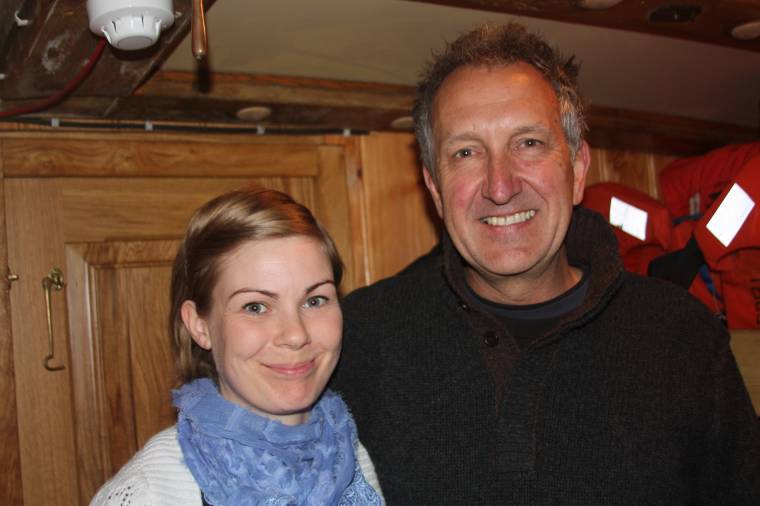
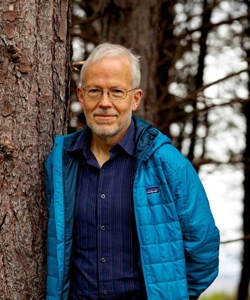
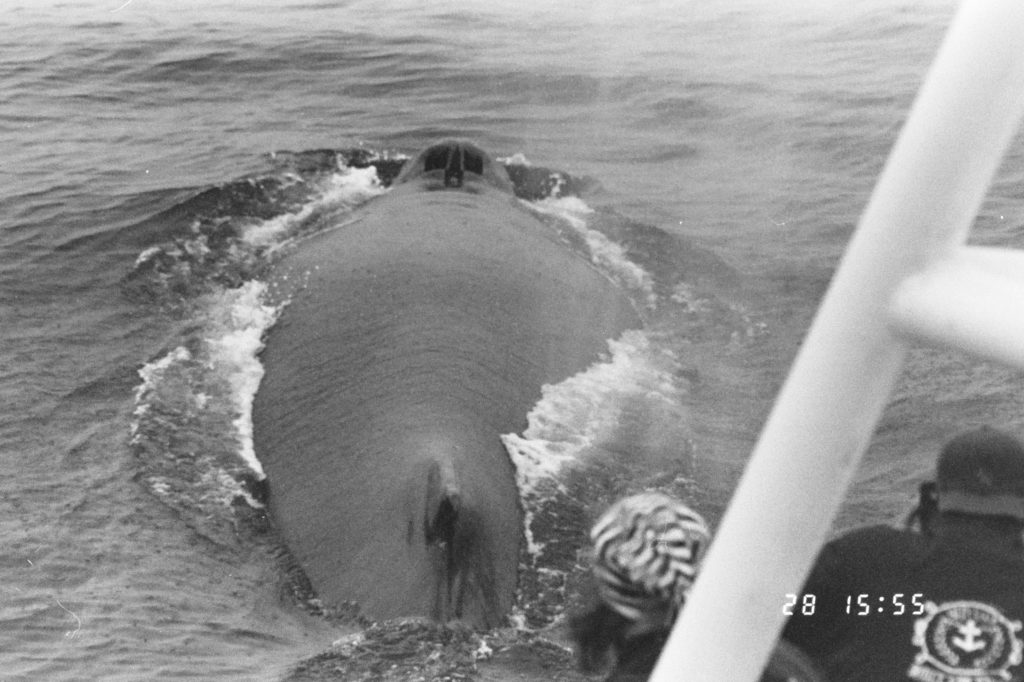
Whale Watching Season Begins in Húsavík
01.03.2019
Today marks the first day of the Whale Watching season of 2019. This is the 25th year that scheduled whale watching tours have been operated from Húsavík.
Two companies, North Sailing and Gentle Giants, sailed out this morning in search of the cetaceans that inhabit the Skjálfandi bay.
Staff from the Whale Museum went down to the harbour to greet the returning ships and bring the crews from the two companies flowers and a gift, a print from the collection of Renata Ortega, a spanish artist who is a great friend of the Húsavík Whale Museum.
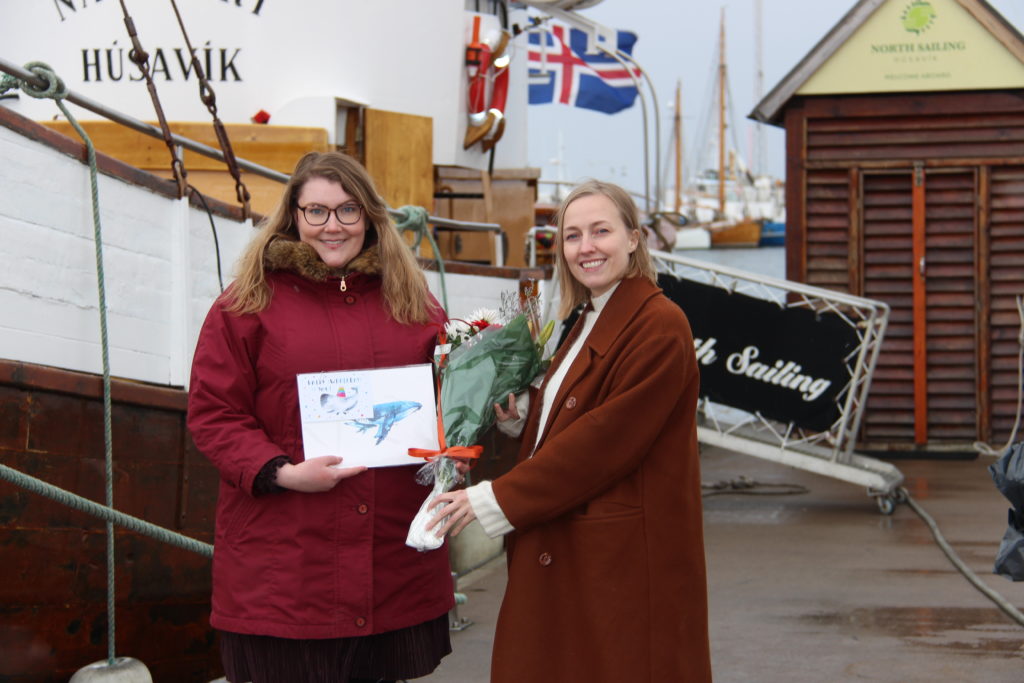
From left: Eva director at the Whale Museum and Líney sales manager of North Sailing
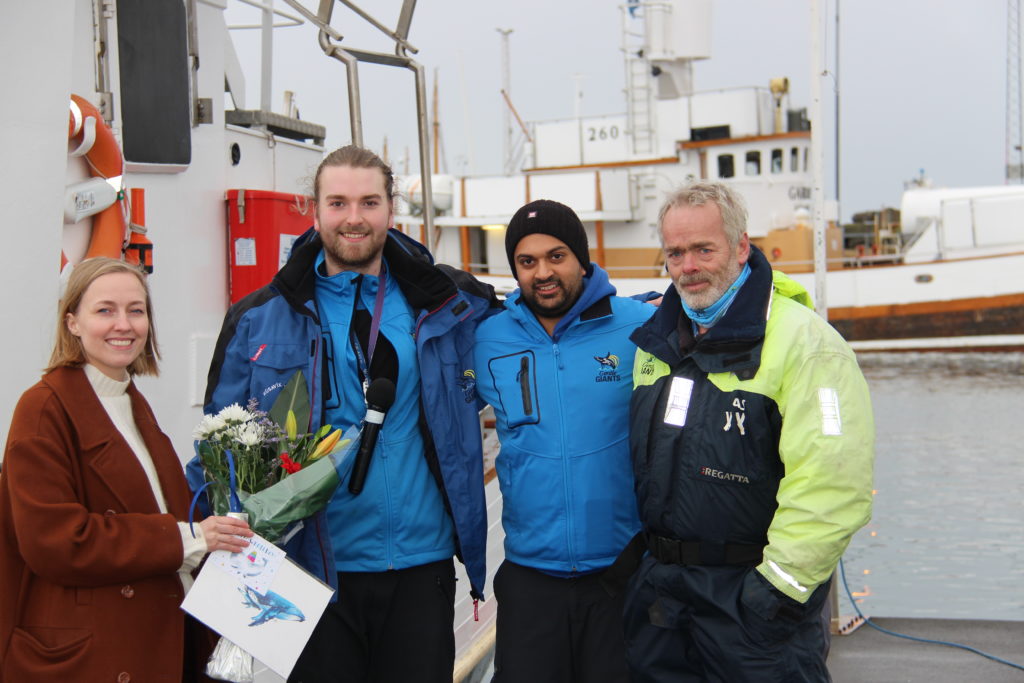
From left: Captain Halli, Daníel assistant manager of Gentle Giants, Aksel tour guide, and Eva director of the Whale Museum
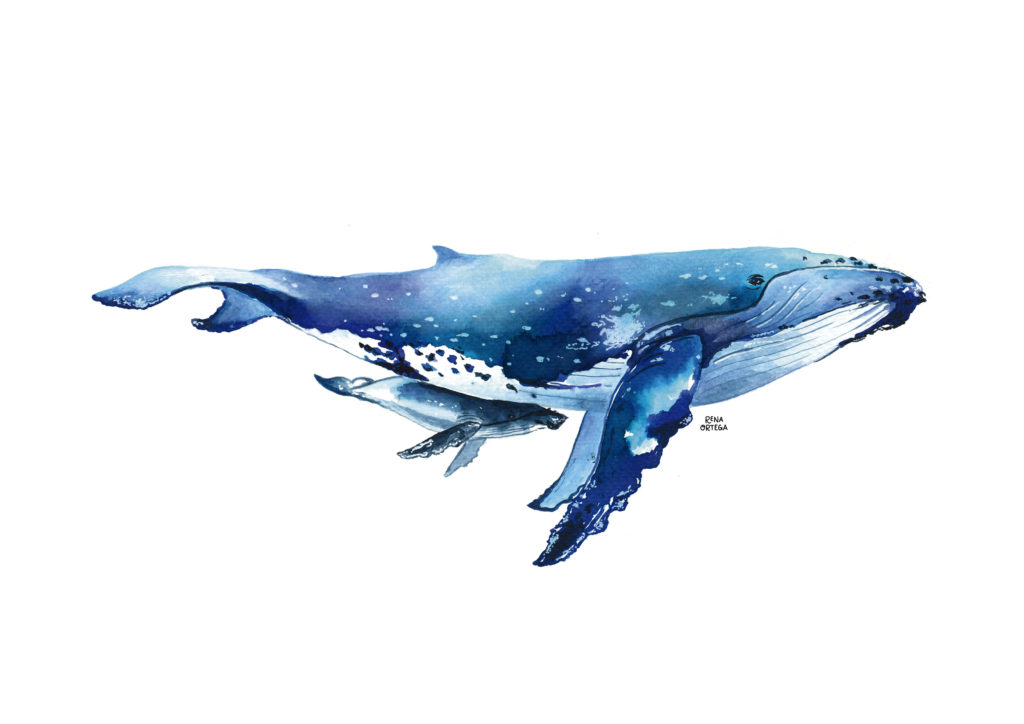
Watercolour print by Renata Ortega, available at our gift shop.
The humpbacks are back to Skjálfandi
The weather has been beautiful this week in Húsavík and the bay is just full of humpback whales. These clumsy but friendly looking whales have been migrating north from their breeding grounds in the carribean.
Christian Schmidt, a guide at North sailing said he had seen between 20 and 30 individual humpbacks on a single trip. He said they seemed to be very hungry and were working together in the feeding process.
The Season has started
Whale watching tours from Húsavík began in early March this year. The weather has been mostly nice and number of guests is gradually increasing. The season has started well and many species have been spotted so far including finwhale, humpback and sei whale.
The Húsavík Whale museum is now open daily from 10:00 – 16:00. The higlight of the museum is the popular full size blue whale skeleton. It is a skeleton of a 25m long female that beached on the land of Ásbúðir in Skagi, North Iceland in 2010.
